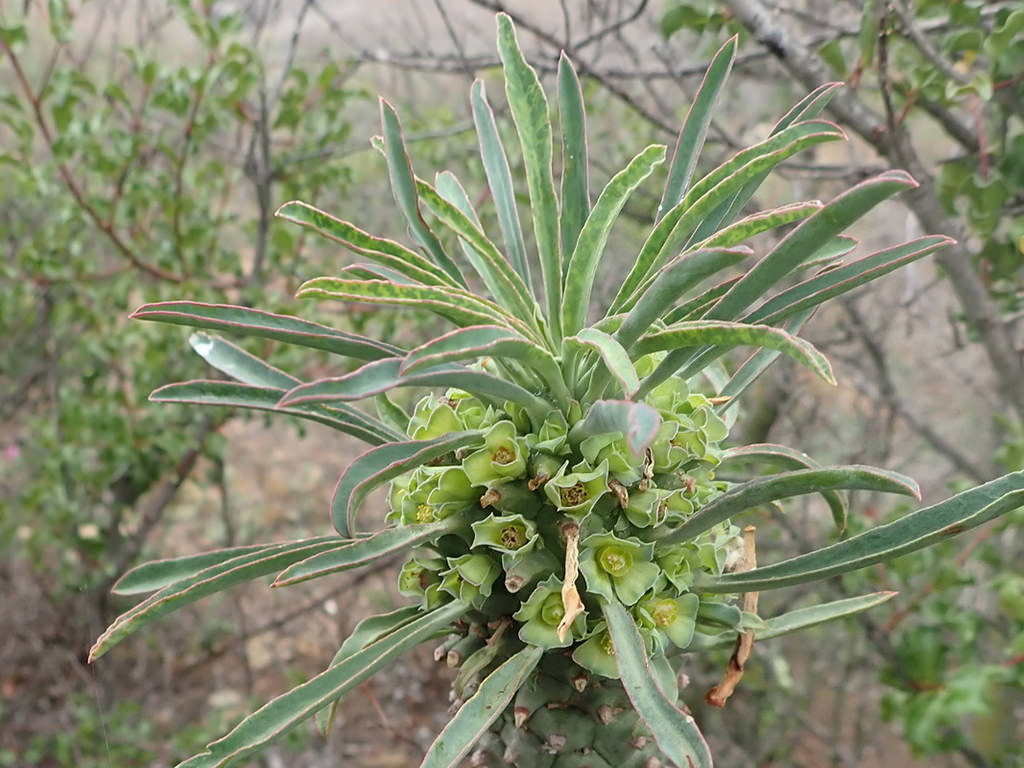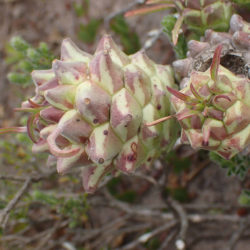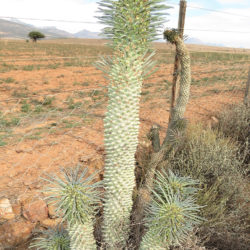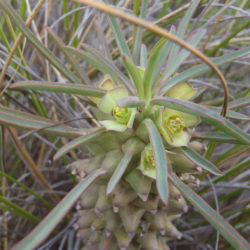Scientific Name
Euphorbia clandestina Jacq.
Common Name(s)
Ostrich Neck, Volstruisnek (Afrikaans)
Scientific Classification
Family: Euphorbiaceae
Subfamily: Euphorbioideae
Tribe: Euphorbieae
Subtribe: Euphorbiinae
Genus: Euphorbia
Origin
This species is native to South Africa (from Swellendam in the west to Uniondale in the east). It usually occurs on rocky hills among low shrubs.
Description
Euphorbia clandestina is a succulent plant with erect green stems with stout conical tubercles arranged in spiraling rows and an apical tuft of linear leaves. It is usually a single-stemmed plant but can grow multi-stemmed over time. The stems are up to 32 inches (80 cm) tall and 2 inches (5 cm) in diameter. In winter, the stems can take on an attractive reddish to purple hue. Leaves are up to 2.4 inches (6 cm) long and about 0.15 inches (0.4 cm) wide. They are green to turquoise-colored, strongly keeled, and minutely hairy. The solitary cyathia are pale yellow and closely surrounded by several bracts.
Etymology
The specific epithet "clandestina (klan-des-TY-nuh)" is the feminine form of the Latin adjective "clandestinus," meaning "clandestine, secret, concealed," and refers to the sessile cyathia hidden by the leaves.

How to Grow and Care for Euphorbia clandestina
Light: This succulent is a sun lover. Place your indoor E. clandestina in a sunny window. You may place the pot on the balcony or in the garden from spring to fall. Increase sun exposure gradually to prevent sunburn.
Soil: E. clandestina requires well-drained soil. Use a commercial mixture formulated for succulents, or make your own potting mix.
Hardiness: High summer temperatures are not a problem, but low winter temperatures can damage or kill your plant. E. clandestina can withstand temperatures as low as 25 to 50 °F (-3.9 to 10 °C), USDA hardiness zones 9b to 11b.
Watering: From spring to fall, water when the top inch (2.5 cm) of soil feels dry. Reduce watering in winter. Give it just enough water to prevent wilting. The best time of the day to water your E. clandestina in the warm season is the evening.
Fertilizing: Plants in a pot need regular feeding. Apply a balanced fertilizer in a 10-10-10 NPK formulation, diluted to 1/4 strength once a week during the growing season.
Repotting: E. clandestina will benefit from repotting, but it does not need to be repotted every year. When your plant is outgrowing its pot, it is time to repot it in a larger pot and give it a fresh potting mix. The repotting is best done in early spring, at the beginning of the growing season. Wear gloves, protective clothing, and appropriate eye protection when repotting this succulent.
Propagation: The easiest and fastest method of propagation for this plant is by using cuttings. It can also be grown from seeds but can be difficult to germinate. The best time to take cuttings is in spring or summer. Sow the seeds in spring.
Learn more at How to Grow and Care for Euphorbia.
Toxicity of Euphorbia clandestina
E. clandestina produces a toxic white milky sap that can cause irritation to the skin and eyes. Therefore, it is best to keep your plant away from children and pets.
Links
- Back to genus Euphorbia
- Succupedia: Browse succulents by Scientific Name, Common Name, Genus, Family, USDA Hardiness Zone, Origin, or cacti by Genus
Photo Gallery
Click on a photo to see a larger version.


